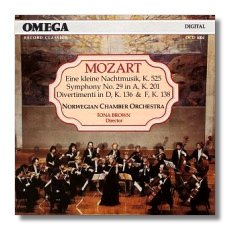
The Internet's Premier Classical Music Source
Related Links
- Mozart Reviews
- Latest Reviews
- More Reviews
-
By Composer
-
Collections
DVD & Blu-ray
Books
Concert Reviews
Articles/Interviews
Software
Audio
Search Amazon
Recommended Links
Site News
 CD Review
CD Review
Wolfgang Mozart

Eine Kleine Nachtmusik
- Eine Kleine Nachtmusik, K. 525
- Symphony #29 in A Major, K. 201
- Divertimento in D Major, K. 136
- Divertimento in F Major, K. 138
Norwegian Chamber Orchestra/Iona Brown
Omega OCD1004 (1988) DDD TT=64:51
A government that does not perish from the earth is still likely to change through the centuries into a form the authors of its constitution could hardly recognize. It is remarkable, then, that an ensemble like the Norwegian Chamber Orchestra that undoubtedly faces a high rate of turnover can maintain a characteristic sound that is both highly individual and instantly recognizable. Whether the group is exploring the Norwegian, English, or Viennese classical repertoire, it never loses the freshness of its individuality, the highly personal sound ideal that Iona Brown has created for the group, reportedly with a strenuous effort – of which not one iota has apparently been wasted.
The rustling of Norwegian pines through the movements of Mozart's serenades, symphony, and divertimenti is only to be expected, in view of how deeply the ensemble's recordings of Grieg's string music are etched in memory. But it's not really Grieg's voice, but the Orchestra's, that is so distinctly audible. The crisp staccato articulation, bold attacks, sharp dynamic contrasts, breathtaking ensemble, and gossamer lightness of the string sound belong to no nationality – and to no other ensemble than the Norwegian Chamber Orchestra. And they change remarkably little over time. When the ensemble played in Ames, Iowa in October, 1995 (Lars Anders Tomter joined Ms. Brown as soloist in Mozart's Sinfonia concertante), they displayed the same musical personality so strongly in evidence on this disc. The effect is visceral. No period instrument group can match the light starchiness of the Norwegian Chamber Orchestra when it is wearing its dress whites.
There might be composers to whom such an approach would not be entirely flattering, but none of these familiar works have ever sounded better or more natural, at least to ears that do not require period-instrument sonorities to make the performance "authentic." Did ensembles in Mozart's own time have the leisure or the technical finesse to produce nuanced performances at this stratospheric level of sophistication and refinement? And did they create this kind of visceral excitement in their performances? Since these works were created for the occasion and not destined for eternal life, it would not be surprising if limited rehearsal time left many details to the unselfconscious if not unconscious sense of style the players tacitly shared. Now, centuries and many thousands of performances of these works later, we substitute the frisson of the superbly played passage for the warm familiarity of a common style. It works – if it didn't, these pieces could never be transplanted into other soils than their native ones. If something is lost, something is also gained, and it may be that in the transaction, the local is traded for the universal, the temporal for the eternal.
The Norwegian Chamber Orchestra, despite the particularity of their style, reach the universal core of these works. That they are well recorded is secondary to the musical achievement, which is considerable. Highly recommended.
Copyright © 1998, Robert Maxham


















